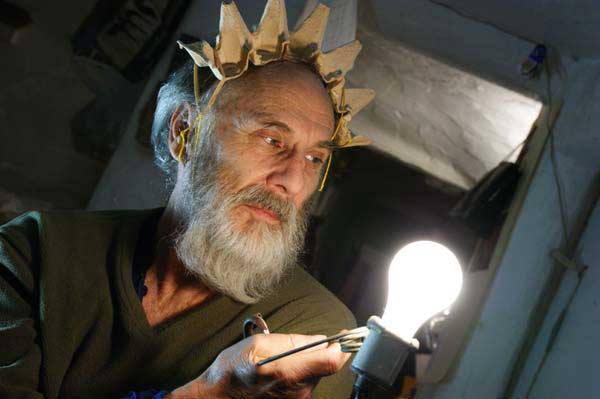By Bryan Rolli
Junk.
At least, that’s what we call it. George Herms, however, marvels at trash heaps and paper scraps, blank canvases awaiting his transformative touch. For nearly 60 years, the Beat-generation artist has drawn from a hodgepodge of discarded, seemingly mundane objects to craft a myriad of collages and sculptures.
Herms’ poignant wit and pathos came to life in dozens of unique pieces on Sunday, Sept. 7 at Austin’s testsite, which is equal parts exhibition space, open studio, short-term residency program and private home. The hybrid venue partnered with local non-profit art initiative Fluent~Collaborative to present “LOVE George Herms,” the artist’s first exhibition in Texas since 2002.
Long revered as a cult figure of the Los Angeles art community, Herms injects his love for both poetry and jazz into all of his pieces. Far from an underground artist, he has received fellowships and grants from several organizations, including The Getty Research Institute and Gottlieb Foundation. His works grace the halls of exhibits, such as the Berkeley Museum of Art and the Menil Collection in Houston.
As for the title of the exhibition, it was a no-brainer — Herms stamps each work with the letters “L-O-V-E,” his signature imprimatur. The simple theme permeated the packed house on Sunday, as Herms warmly addressed an enrapt audience about his lust for life, his role in the Beat movement — a post World War II surge in writers and creative literature — and the decades of glorified “junk mail” that he has given new life.
“The objects tell me what to do,” Herms says of his eclectic works, which included everything from melted CDs to postage stamps to magazine cutouts. “I have no architect’s blueprint when I’m starting out, and then they just organically grow into whatever it is they’re going to be.”
Herms delegated the entire selection process to curator Sarah Bancroft, who combed through the prolific artist’s entire collection to provide a brief glimpse into his career that still managed to span decades.“For me, it’s about letting the artwork do its job, so I need to show the artwork to its best advantage and get out of the way,” Bancroft says of her role in crafting the multi-sensory exhibition. “It’s a visual and an intellectual experience when a person engages with art.”
This wasn’t just a club for highbrow enthusiasts, as U.S. Navy Capt. Burt Quintanilla, a friend of Herms’ for several years, demonstrated. “I don’t usually run in an art circle. That’s not where the military usually hangs out. But I feel that he has changed my mind about a lot of things in life, only because he makes me look at them differently,” Quintanilla says. “Here’s what happens: Stuff clears my desk. I go with George, and things bloom from his table. You see? My desk. His table.”
Inevitably, the source of Herms’ inspiration always comes into question. Lucky for him, this world has no shortage of disposable objects – and that doesn’t seem likely to change.
“This is the most materialistic place in the whole universe, and it’s unending, I swear to God,” he insists In fact, he must constantly remind himself that other people’s knick-knacks are not fair game. “It’s kind of scary when I go somewhere and I have to almost, ‘Stop!’” he exclaims, swatting his own hand for emphasis. “These are your friends; you don’t want to steal from your friends, man!”
So what keeps the 79-year-old Herms on his toes after all this time? “The challenge, really, which one accepts, is to turn everything into art,” he says. “So, the more mundane an object is, the more banal, the greater the challenge to make something elegant and beautiful.”
This may seem like a daunting task, but Herms doesn’t face it alone. Instead, he sees himself as a vessel, and attributes his creative prowess to a higher power than himself. “It’s as though I’m a saxophone, and God is Charlie Parker,” Herms says. “It’s my job to keep all these things open.”
















































